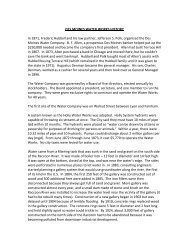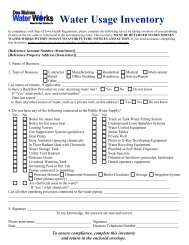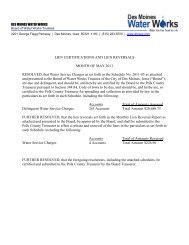Fact Sheet Nitrate Removal Facility - Des Moines Water Works
Fact Sheet Nitrate Removal Facility - Des Moines Water Works
Fact Sheet Nitrate Removal Facility - Des Moines Water Works
Create successful ePaper yourself
Turn your PDF publications into a flip-book with our unique Google optimized e-Paper software.
Q: Does this create a bigger problem for the cities and water utilities downstream?No. Returning nitrate to the river does not impact the river’s total nitrate load. River nitrateconcentrations are so high that cities downstream would have a nitrate problem even if DMWW didnot discharge back into the river. For example, the daily nitrate load in the Raccoon River canapproach 700 tons; of this amount, less than 0.10% would pass through the nitrate removal facilityand be returned to the river. Other practical disposal methods are not available at this time.It’s also important to remember that DMWW actually decreases the nitrate load in the Raccoon Riverthrough the diversion of river water into the <strong>Water</strong> <strong>Works</strong> Park ponds and Crystal Lake (former gravalpit) near the Maffitt Treatment Plant. In the ponds and Crystal Lake, nitrate is consumed andconverted to nitrogen gas by the life processes of microorganisms before the water is dischargedback into the river or treated for customer use. DMWW removes about 75,000 pounds of nitrate fromthe river each year in this manner.Q: Does DMWW need special permission to discharge the nitrate back into the river?Yes, DMWW has two National Pollutant Discharge Elimination System (NPDES) permits allowingdischarge of the nitrate. Prior to issuing the permits, the Iowa Department of Natural Resources(IDNR), as authorized by the Federal Clean <strong>Water</strong> Act, requested public review and comment on thedischarge permits. The permits were also reviewed and approved by the Environmental ProtectionAgency (EPA).Q: How can we prevent nitrate from getting into our source water?The optimal solution is to prevent nitrate concentrations from entering our source water throughwatershed protection programs and good land management practices.Q: What are the health effects of nitrate?In infants under six months of age, nitrate may transform into nitrite in the infant’s body, reducing theability of blood to carry oxygen. This may cause “Blue Baby Syndrome,” a life threatening conditionrequiring immediate medical attention. Symptoms of “Blue Baby Syndrome” include the infantlooking blue and having shortness of breath.Blue Baby Syndrome is very seldom diagnosed today. But, on the horizon are other health concernsrelating to <strong>Nitrate</strong>s. Research supports a strong correlation between nitrates and certain types ofcancer in adults. There is also emerging data implicating nitrate as an endocrine disruptor, meaningnitrate may act as a hormone in the body.Q: Why are babies under six months of age at risk?(1) The intestinal pH is higher in infants, enhancing the bacterial conversion of nitrate to nitrite.(2) Infants require three times the fluid intake of adults, increasing the blood circulation and thenitrate absorption. (3) The infant’s immature kidneys reduce the excretion of the nitrate. (4) Thepresence of the enzyme responsible for preventing “Blue Baby Syndrome” is lower than in adults andchildren over six months of age.









